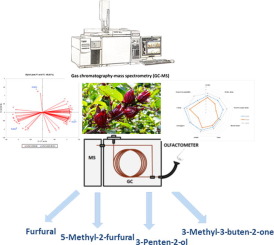Food Research International ( IF 8.1 ) Pub Date : 2020-02-27 , DOI: 10.1016/j.foodres.2020.109133 Oscar Zannou 1 , Hasim Kelebek 2 , Serkan Selli 1

|
Roselle (Hibiscus sabdariffa L.) is an edible flower belonging to the large family of Malvaceae. Aroma is one of the crucial parameters to determine the final tea overall quality and the consumer's preference and it is affected by different processing factors (drying, heating, brewing etc.). The aim of this study was to compare hot and cold brewing procedures on the aroma and aroma-active compounds of Beninese Roselle for the first time. Three different infusions were prepared and coded as R16M (16 minutes/98°C), R40M (40 minutes/98°C) and R24H (24 hours/at ambient temperature). The aroma compounds of the infusion samples were extracted by liquid liquid extraction (LLE) method and determined by gas chromatography-mass spectrometry (GC-MS). A total of 38, 38 and 39 aroma compounds including alcohols, furans, acids, ketones, aldehydes, volatile phenols, lactones, pyranone, pyrrole, terpene and ester were detected in R16M, R40M and R24H infusions, respectively. The total aroma concentration of the cold infusion sample (R24H) was higher than those of two hot infusions. A significant reduction was found in the amount of these compounds in the sample prepared by hot infusion with 16 min (R16M). In all three samples, furans were identified as the dominant aroma group followed by alcohols. Based on the results of the aroma extract dilution analysis (AEDA), a total of 22 and 23 different key odorants were detected in hot infusions (R16M and R40M) and cold infusion (R24H) (ambient temperature), respectively. The powerful key odorants with regard to FD (flavor dilution) factors in all samples were prevailingly furans, alcohols, and aldehydes. The highest FD factors were found in furfural and 5-methyl-2-furfural providing caramel and bready notes. Principal component analysis (PCA) showed that Roselle infusions could clearly be discriminated in terms of their aroma profiles. The findings of this study demonstrate that the brewing procedures have a important impact on the final aroma and key odorants of Roselle infusions.
中文翻译:

阐明通过热和冷冲泡制备的Beninese Roselle(Hibiscus sabdariffa L.)输液中的主要气味。
玫瑰茄(木槿sabdariffaL.)是属于锦葵科大家族的食用花卉。香气是确定最终茶的整体质量和消费者喜好的关键参数之一,并且受不同加工因素(干燥,加热,冲泡等)的影响。这项研究的目的是第一次比较热和冷的酿造程序对Beninese Roselle的香气和香气活性化合物的影响。制备了三种不同的输液,其编码为R16M(16分钟/ 98°C),R40M(40分钟/ 98°C)和R24H(24小时/在环境温度下)。通过液液萃取(LLE)法提取输液样品的香气成分,并通过气相色谱-质谱法(GC-MS)测定。总共38、38和39种芳香化合物,包括醇,呋喃,酸,酮,醛,挥发性酚,内酯,吡喃酮,在R16M,R40M和R24H输注液中分别检出了吡咯,萜烯和酯。冷注入样品(R24H)的总香气浓度高于两次热注入的香气浓度。发现通过热输注16分钟(R16M)制备的样品中这些化合物的量显着减少。在所有三个样品中,呋喃被确定为主要的香气基团,其次是酒精。根据香气提取物稀释分析(AEDA)的结果,分别在热注入(R16M和R40M)和冷注入(R24H)(环境温度)中分别检测到22种和23种不同的关键气味。在所有样品中,与FD(风味物质稀释)因子相关的最重要的主要气味主要是呋喃,醇和醛。糠醛和5-甲基-2-糠醛中的FD因子最高,具有焦糖和面包味。主成分分析(PCA)显示,可以根据其香气成分清楚地区分Roselle浸泡液。这项研究的结果表明,冲泡过程对玫瑰茄浸液的最终香气和主要气味有重要影响。

























 京公网安备 11010802027423号
京公网安备 11010802027423号